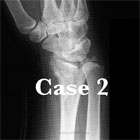|


|
synonyms:distal radius fracture, distal radius ORIF, wrist fracture ORIF, distal radius fracture operative treatment
Distal Radius Fracture ORIF CPT
Distal Radius Fracture ORIF Indications
- Radiocarpal subluxation / dislocation (volar or dorsal)
- Displaced Radial-styloid fracture
- Rotated, volar lunate-facet fracture
- Displaced articular fractures that have failure closed reduction
- Bilateral displaced distal radius fracture
- Associated ipsilateral injury or DRUJ instability
- Open fracture
- Failure to maintain closed reduction
- Associated neurovascular injury (median nerve)
Distal Radius Fracture ORIF Contraindications
- Comorbid medical conditions preventing anesthesia
- Active infection
- Comples regional pain syndrome
- Severe local soft-tissue injury
Distal Radius Fracture ORIF Alternatives
- External Fixation
- Closed reduction and casting
- Spanning internal fixation (Ruch DS, JBJS 2005;87A:945).
Distal Radius Fracture ORIF Pre-op Planning / Special Considerations
- Pre-operative plan surgery using AO Technique based on pre-op P/A, oblique and lateral views.
- Consider CT and post-reduction views to further define fracture pattern
- Ensure appropriate plates / screws, bone graft / bone graft substitutes are available.
- Dorsal approach through 3rd dorsal compartment
- Volar approach between FCR & radial artery
- Reduction or fixation may be supplemented with Norion SRS cement(osteoconductive carbonated apatite) may be used as supplement. (Cassidy, JBJS 2003;85A:2127).
- 20° lateral c-arm views best shows lunate facet reduction (Medoff RJ, Hand Clin 2005;21:279).
Distal Radius Fracture ORIF Technique
- Pre-operative antibiotics, +/- regional block
- General endotracheal anesthesia
- Supine position with hard table. Ensure appropriate C-arm images can be taken.
- All bony prominences well padded.
- Examination under anesthesia.
- Tourniquet placed high on the arm.
- Prep and drape in standard sterile fashion.
- Incision 10cm long, along the FCR tendon, zig-zagged over the wrist flexion crease.
- Dissection with 2.5/3.5 loop magnification. Dissect distal to the superficial radial artery. Ensure artery is preserved.
- Dissect to FCR Tendon sheath. Incise FCR tendon sheath. Retract tendon ulnarly
- Incise floor of FCR tendon sheath. Develop plane between FPL and the radial septum exposing the pronator quadratus.
- Release pronator quadratus with a distally based L-shaped incision exposing volar surface of distal radius.
- Irrigate and debride fracture site.
- Extended exposure can be achieved by pronation of the proximal fragment and/or opening the first extensor comparmtne and retracting the APL and EPB tendons or performing a step-cut release the of the brachioradialis insertion.
- Reduce fracture (traction/ligamentotaxis/direct pressure/reduction forceps)
- Consider provisional K-wire fixation.
- Fixation provided as described by manufacture technique guide using AO techniques.
- Varify reduction and screw position flouroscopically. Images with beam inclined 20 degrees from distal to proximal are key to confirm articular reduction.
- Evaluated DRUJ stability after fracture fixation and compare to uninjured side.
- Repair pronator quadratus over the plate.
- Irrigate.
- Close in layers.
Distal Radius Fracture ORIF Complications
- Malunion = typically loss of radial height, ulnar and volar inclination less commonly inarticular incongruity.
- Nonunion: uncommon except with volar and dorsal plating with extensive sub-periosteal stripping.
- Distal radioulnar joint injury
- Contracture / stiffness
- Neurologic injury
- Complex regional pain syndrome(CRPS) (2-20%)
- Hardware failure
- Painful Hardware
- Tendon injury / rupture
- Infection
- Cartilage injury / arthritis
- risks of surgery including but not limited to: malunion, nonunion, stiffness, CRPS, nerve or vascular injury, painful hardware, loss of fixation, tendon injury, infection, arthritis, incomplete relief of pain, incomplete return of function and the risks of anesthesia including heart attack, stroke, and death.
Distal Radius Fracture ORIF Follow-up care
- Post-Op: Place in volar splint. Encourage digital ROM, elevation.
- 7-10 Days: remove splint. Place in short arm cast. Consider removable splint with gentle ROM if fixation was extremely secure.
- 6 Weeks: Cast removed. Check xrays. Started gentle ROM exercises. Activity modifications: no heavy manual labor, no contact sports, no lifting >5 lbs.
- 3 Months: Check xrays. If union is complete return to full activities.
Distal Radius Fracture ORIF Outcomes
Distal Radius Fracture ORIF Review References
- Greens Hand Surgery
- Rockwood and Green's Fractures in Adults 6th ed, 2006
|


